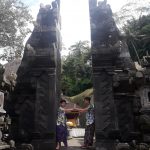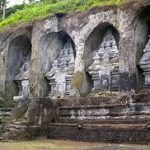Gunung Kawi Temple is an 11th-century temple complex in Tampak Siring north east of Ubud in Bali Indonesia. It is located on the river Pakrisan.
The temple complex comprises of 10 rock-cut candi (shrines) carved into the cliff face. They stand in 7m high (23 ft) sheltered niches cut into the sheer cliff face. These monuments are thought to be dedicated to King Anak Wungsu of the Udayana dynasty and his favourite queens.
Gunung Kawi is a Hindu Temple complex with old omission from the stone era located in Gianyar regency. Based on the inscription of Tengkulak A on 945 saka (Balinese calendar) which is released by Marakata King, the ancient omission complex is located at the Pekerisan River then it is called Katyangan Amarawati. Pekerisan River is also named by Jalu which is according to the inscription chiseled above of the biggest temple door sound ‘Haji Lumahing Jalu’. The name of Gunung Kawi is the name given on the omission which is related to the complex of temples because the temple in this area is like the symbol from the mount. There are 3 temples which are called Gunung Kawi in Bali and they are Gunung Kawi in Sebatu countryside, Gunung Kawi Temple in Keliki countryside and Gunung Kawi Temple in Babitra countryside. The ancient omission complex of Gunung Kawi was founded in the 10th century. It is founded in the era of Udayana about 989 M. At the period of Marakata governance in 1023, the omission which is called Katyagan Amarawati was developed and continued by the governance of Anak Wungsu which is between the years of 1049 – 1077 M









